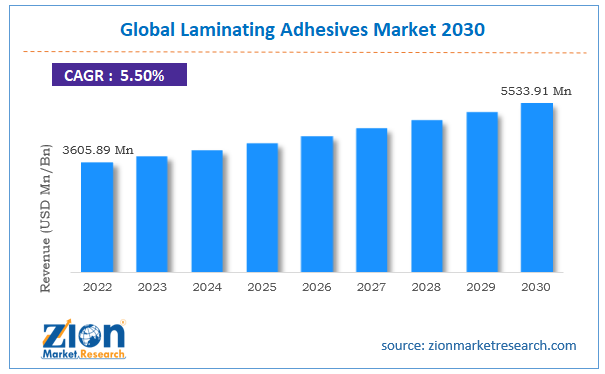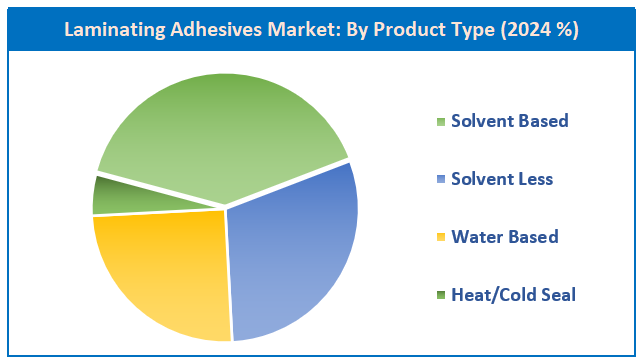Laminating Adhesives Market Size, Share, Trends, Growth 2030

Laminating Adhesives Market By Product Type [Solvent Based, Solvent Less, Water Based, and Heat/Cold Seal], By End-User [Medical Packaging, Food Packaging, Industrial Packaging, and Other End Use] , And By Region - Global And Regional Industry Overview, Market Intelligence, Comprehensive Analysis, Historical Data, And Forecasts 2023 - 2030
| Market Size in 2022 | Market Forecast in 2030 | CAGR (in %) | Base Year |
|---|---|---|---|
| USD 3,605.89 Million | USD 5,533.91 Million | 5.50% | 2022 |
Description
Laminating Adhesives Industry Perspective:
The global laminating adhesives market size was worth around USD 3,605.89 million in 2022 and is predicted to grow to around USD 5,533.91 million by 2030 with a compound annual growth rate (CAGR) of roughly 5.50% between 2023 and 2030.
Global Laminating Adhesives Market: Overview
Laminating adhesives keep intact the substrates together after the lamination process. Several notable benefits provided by laminating adhesives include increased or decreased gas permeability, flame resistance, electrical insulation, heat resistance, thermoforming capability, chemical resistance, and optical clarity. Laminating adhesives are used in a wide range of end-use applications such as pharmaceutical, food pouches, frozen food cartons, medical, agricultural containers, industrial, papers & graphics, instant photograph, and mold label.
Key Insights:
- As per the analysis shared by our research analyst, the global laminating adhesives market is estimated to grow annually at a CAGR of around 5.50% over the forecast period (2023-2030)
- In terms of revenue, the global laminating adhesives market tsize was valued at around USD 3,605.89 Million in 2022 and is projected to reach USD 5,533.91 Million by 2030.
- Based on the Product Type, the solvent based, solvent less, water based, and heat/cold seal segment is expected to lead the market, while the wheat segment is expected to grow considerably.
- Based on End User, the medical packaging, food packaging, industrial packaging segment is the dominating segment, while the domestic consumers segment is projected to witness sizeable revenue over the forecast period.
- Based on region, Asia Pacific is projected to dominate the global market during the estimated period, followed by Latin American.
Global Laminating Adhesives Market: Growth factors
Laminating adhesives for flexible packaging are one of the promising adhesive solutions extensively utilized in food packaging sector. The laminating adhesives are anticipated to witness high demand in the coming years, mainly owing to factors such as lower wastage, lesser treatment time, lesser emission, and higher bond strength. Also, rising demand for package foods in healthcare and personal care goods have augmented market growth. On the other hand, the government programs and increasing consumer awareness towards the practice of ecological adhesives have restricted the growth of the laminating adhesives, further hampering the growth of the global laminating adhesives market.
Global Laminating Adhesives Market: Segmentation
The global laminating adhesives market is segmented on the basis of end use, product type, and region.
Based on the Product Type, the global market is bifurcated as solvent based, solvent less, water based, and heat/cold seal.
Based on the End User, the global laminating adhesives market is segmented into medical packaging, food packaging, industrial packaging, and other end use. Though food wrapping in the end use segment remains the dominant segment, laminating adhesives are expected to experience high demand in the medical packaging industry during the coming years.
Recent Developmentst
- In 2023, Henkel announced solvent-free flexible laminating adhesives intended for food contact, enhancing bonding on bio-based films by 42% and cure speed by 38%.
- In May 2023, a stake in Beardow Adam, a UK-located innovator in sustainable adhesives, was acquired by H.B. Fuller, strengthening its market and technological reach.
- In Nov 2022, Sun Chemical (part of DIC) acquired SAPICI, expanding into high-performance polyurethanes for flexible packaging and coatings.
- In 2023, Henkel launched a bio-based flexible laminating adhesive line with over 30% plant-derived content, aiming at pharma and food packaging, thus attracting rapid adoption.
- In Dec 2024, Arkema finalized its procurement of the flexible packaging laminating adhesives business of Dow for $150 million. The acquisition comprises prominent brands like MOR-FREE™ and ADCOTE™, around $250 million in annual sales, and 5 production sites in the U.S., Italy, and Mexico.
Laminating Adhesives Market : Report Scope
| Report Attributes | Report Details |
|---|---|
| Report Name | Laminating Adhesives Market Research Report |
| Market Size in 2022 | USD 3,605.89 Million |
| Market Forecast in 2030 | USD 5,533.91 Million |
| Growth Rate | CAGR of 5.50% |
| Number of Pages | 215 |
| Key Companies Covered | Flint Group, H.B. Fuller, The Dow Chemical Company, Ashland Inc., Morchem, DIC Corporation, Henkel AG & Co. KGaA, 3M, Arkema Group, Coim Group, and Chemline India Ltd. |
| Segments Covered | By Product Type, By End-Use and By Region |
| Regions Covered | North America, Europe, Asia Pacific (APAC), Latin America, Middle East, and Africa (MEA) |
| Base Year | 2022 |
| Historical Year | 2017 to 2021 |
| Forecast Year | 2023 - 2030 |
| Customization Scope | Avail customized purchase options to meet your exact research needs. Request For Customization |
Laminating Adhesives Market Dynamics
Key Growth Drivers
The laminating adhesives market is primarily driven by the escalating demand for flexible packaging across various end-use industries, particularly food and beverages, pharmaceuticals, and consumer goods. Flexible packaging offers numerous benefits, including being lightweight, cost-effective, and providing excellent barrier protection and extended shelf life for products. The rapid growth of the e-commerce sector has further fueled this demand, as it necessitates durable and visually appealing packaging solutions for safe transit. Additionally, the automotive and electronics industries are increasingly adopting laminating adhesives to achieve lighter vehicles and more efficient devices, contributing to market expansion.
Restraints
Despite the robust growth, the market faces significant restraints, primarily the high and volatile prices of raw materials. The production of laminating adhesives, particularly polyurethane-based ones, relies on petrochemical derivatives, making them susceptible to price fluctuations in the crude oil market. This volatility can impact production costs and, consequently, the final product price, challenging manufacturers to maintain competitive pricing. Another key restraint is the stringent environmental regulations in regions like North America and Europe, which are aimed at limiting volatile organic compound (VOC) emissions from solvent-based adhesives. Complying with these regulations often requires manufacturers to invest in new technologies and formulations, such as water-based or solvent-free adhesives, which can be more expensive.
Opportunities
The market is ripe with opportunities driven by a global shift towards sustainability. There is a growing trend and market demand for eco-friendly adhesives, including water-based, solvent-free, and bio-based formulations. These alternatives reduce VOC emissions and align with increasingly strict environmental regulations, presenting a lucrative avenue for market players who can innovate in this space. Furthermore, the rapid industrialization and urbanization in emerging economies, particularly in the Asia-Pacific region, are creating a booming market for flexible packaging and, by extension, laminating adhesives. Manufacturers who can establish a strong presence and develop tailored products for these markets are poised for significant growth.
Challenges
The laminating adhesives market faces several challenges, including the complex nature of product development and the need to meet diverse performance requirements. Adhesives must provide strong, reliable bonds under varying environmental conditions and across different substrates, which can be a technical hurdle. Additionally, a major health-related challenge is the potential migration of primary aromatic amines (PAAs) from certain polyurethane-based adhesives into food, which raises safety concerns. While the industry is moving towards safer alternatives, this issue requires continuous monitoring and innovation to ensure compliance with food safety standards and maintain consumer trust.
Global Laminating Adhesives Market: Regional Analysis
By region, the global laminating adhesives market is segmented as Europe, Latin America, North America, Asia-Pacific, and the Middle East and Africa. The market in Asia-Pacific is projected to register a fixed Y-o-Y growth in the near future. In Asia Pacific, China and India are expected to see maximum Y-o-Y growth in the coming years. Europe and Asia Pacific are anticipated to dominate the global market and witness considerable growth in the lamination adhesives market. This growth is mainly due to the developing and emerging mature markets in these regions. Rising end-use industry growth is anticipated to boost the laminating adhesives demand in the Asia Pacific region.
Growing number of niche market players in various market segments along with rising domestically production capacity in economies such as India, China, and Japan is anticipated to propel the laminating adhesives market growth in the Asia-Pacific region in the near future. Emerging countries of Southeast Asia including Indonesia, Malaysia, and Thailand organize chemical industry specific events all around the world. This is expected to have a positive impact on the growth of the laminating adhesives market in Asia Pacific.
Global Laminating Adhesives Market: Competitive Players
The global laminating adhesives market is led by players like:
- Flint Group
- H.B. Fuller
- The Dow Chemical Company
- Ashland Inc
- Morchem
- DIC Corporation
- Henkel AG & Co. KGaA
- 3M
- Arkema Group
- Coim Group
- Chemline India Ltd
The global laminating adhesives market is segmented as follows:
By Product Type
- Solvent Based
- Solvent Less
- Water Based
- Heat/Cold Seal
By End-Use
- Medical Packaging
- Food Packaging
- Industrial Packaging
- Other
Global Laminating Adhesives Market: Regional Segment Analysis
- North America
- U.S.
- Europe
- UK
- France
- Germany
- Asia Pacific
- China
- Japan
- India
- Latin America
- Brazil
- The Middle East and Africa
What Report Provides
- Full in-depth analysis of the parent market
- Important changes in market dynamics
- Segmentation details of the market
- Former, on-going, and projected market analysis in terms of volume and value
- Assessment of niche industry developments
- Market share analysis
- Key strategies of major players
- Emerging segments and regional markets
- Testimonials to companies in order to fortify their foothold in the market.
Table Of Content
FrequentlyAsked Questions
Laminating adhesives are a category of adhesives that are utilized during the lamination process, which entails the joining of two or more substrates in order to produce a composite material. The principal objective of laminating adhesives is to preserve the intended characteristics of each individual substrate while establishing a robust and long-lasting connection between the layers. The substrates utilized in the lamination process exhibit significant diversity and may comprise foam, coatings, foils, papers, or fabrics. The selection of laminating adhesives is determined by a variety of factors, including the intended application of the laminated product, the materials being laminated, and the desired bond strength and flexibility.
The market for laminating adhesives is notably impacted by the packaging sector. The growing need for adaptable packaging solutions, propelled by developments in e-commerce, convenience packaging, and sustainability, is anticipated to contribute to the demand for laminating adhesives. Market expansion may be influenced by advancements in adhesive technologies, such as the creation of environmentally favorable and sustainable formulations. A competitive advantage may accrue to producers of high-performance adhesives that feature enhanced efficiency, bonding strength, and environmental tolerance.
The global laminating adhesives market size was worth around USD 3,605.89 million in 2022 and is predicted to grow to around USD 5,533.91 million by 2030.
The global laminating adhesives market with a compound annual growth rate (CAGR) of roughly 5.50% between 2023 and 2030.
By region, the global laminating adhesives market is segmented as Europe, Latin America, North America, Asia-Pacific, and the Middle East and Africa. The market in Asia-Pacific is projected to register a fixed Y-o-Y growth in the near future. In Asia Pacific, China and India are expected to see maximum Y-o-Y growth in the coming years. Europe and Asia Pacific are anticipated to dominate the global market and witness considerable growth in the lamination adhesives market.
Major players in the global laminating adhesives market are Flint Group, H.B. Fuller, The Dow Chemical Company, Ashland Inc., Morchem, DIC Corporation, Henkel AG & Co. KGaA, 3M, Arkema Group, Coim Group, and Chemline India Ltd.
HappyClients
Zion Market Research
Tel: +1 (302) 444-0166
USA/Canada Toll Free No.+1 (855) 465-4651
3rd Floor,
Mrunal Paradise, Opp Maharaja Hotel,
Pimple Gurav, Pune 411061,
Maharashtra, India
Phone No +91 7768 006 007, +91 7768 006 008
US OFFICE NO +1 (302) 444-0166
US/CAN TOLL FREE +1 (855) 465-4651
Email: sales@zionmarketresearch.com
We have secured system to process your transaction.
Our support available to help you 24 hours a day, five days a week.
Monday - Friday: 9AM - 6PM
Saturday - Sunday: Closed







